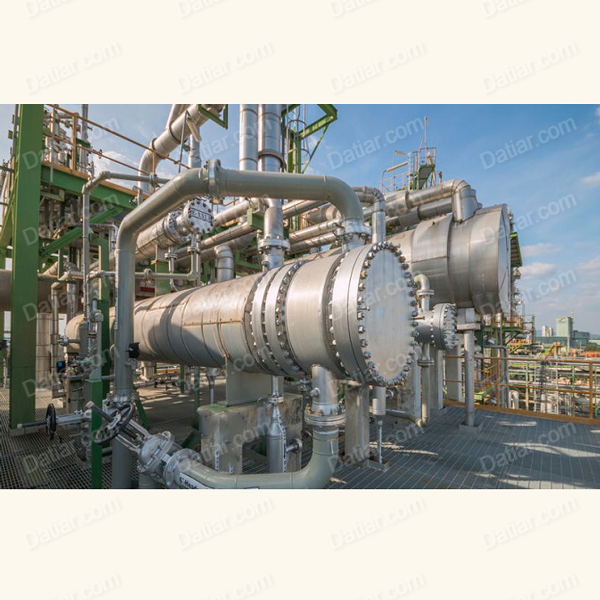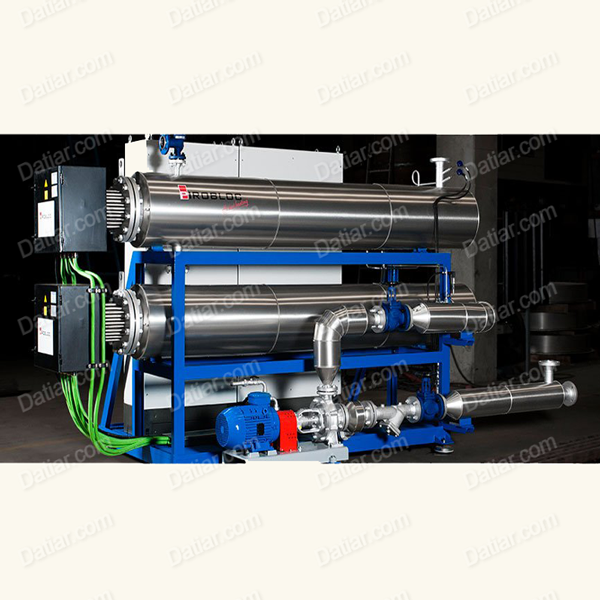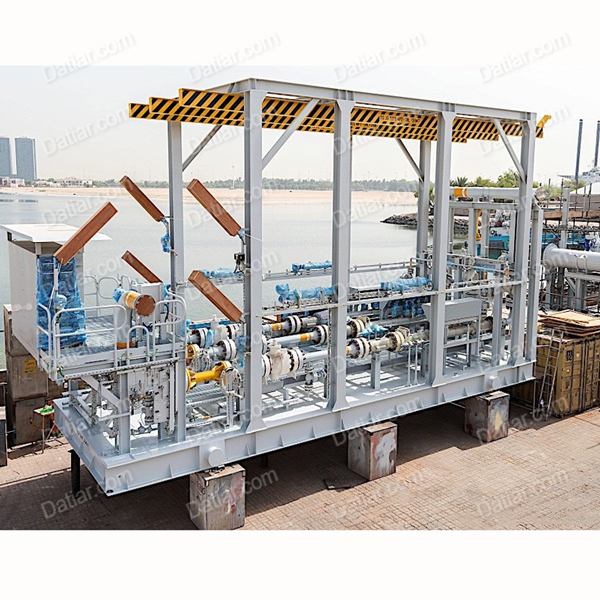Wastewater Treatment
One of the activities that Danativara company specializes in is wastewater treatment. Clean water is one of the most valuable human resources. That is why we treat it with great care and respect. Danativara company tries to reduce the amount of water consumed by processes, we take all possible measures to prevent pollution and we use very effective methods, some of which we have invented and developed ourselves, to purify polluted water.
Water; with an impressive role in chemistry
Water is absolutely vital to chemistry. In fact, it is a key component in the products, a solvent, cleaning and cooling agent, an energy source in the form of steam, and of course, it plays an essential role in the daily life of the people who work with it.
Three quarters of this water is used for cooling purposes in production facilities. During this process, the cooling water does not come into contact with the products. After conducting the necessary investigations, we can return this cooling water directly to the source through a separate system. Wastewater containing mineral pollutants such as rainwater without pollutants can be directly returned to the source without the need for treatment.
Only about ten percent of the water used actually comes into contact with the products and subsequently needs to be treated. This includes acidic, alkaline, and organic wastewater from production facilities, laboratories, and technical service centers, as well as sanitary and kitchen wastewater.
This water is completely treated in our own biological wastewater treatment plant in Danativara. Physical or chemical pretreatment measures are carried out upstream (source) where the water is contaminated. Substances that can prevent biological treatment or cannot be removed by biological methods are removed in the production plants themselves. Then the treated effluent flows to the source.
Wastewater treatment process
Polluted municipal and industrial wastewater can be treated very efficiently. Today’s modern wastewater treatment is carried out in several stages depending on the specific substances in the water:
• Mechanical removal of coarse materials and sand (granulation and garbage removal)
• Neutralization (acidic and alkaline wastewater is neutralized to avoid any impact on the subsequent biological treatment process)
• Pre-sedimentation for simultaneous separation of undissolved substances and substances consumed by bacteria.
Secondary clarification is for separating biological sludge from purified water. A part of this biological sludge is returned to the biological sludge from the purified water. The rest is transferred to the sludge treatment section.
Neutralization
Due to the nature of production, the effluent is usually strongly acidic (pH value approximately 1.5). To protect the bacteria in the treatment plant, milk of lime is added to the wastewater according to the pH level. This causes the precipitation of minerals (such as calcium, aluminum and iron) and also some organic materials.
pre-settlement
In the next step, pre-sedimentation, sediment products from the neutralization process and other solids sink to the bottom and are mechanically removed. The resulting sludge is collected together with the sludge from other treatment steps and transferred to the sewage sludge treatment system.
Intermediate storage
Pre-treated and neutralized wastewater is stored in buffer tanks, where the concentration and volume of the effluent flow are equalized. This improves the degradation performance in subsequent biological treatment.
Purification in the Biology Tower (Solar Center Tower)
The concept of the processes involved in the biological treatment of wastewater is comparable to the natural self-cleaning capacity of rivers and lakes. Bacteria use the substances in the sewage and water-soluble oxygen to convert these substances into carbon dioxide, water and biomass, and in a limited area and on a much shorter time scale than what occurs in nature. are formed
Bacteria also need to mix well with oxygen, and the tower biology system achieves this very effectively. Process engineers at the Danativara complex have succeeded in finding an energy-efficient way to introduce the oxygen atmosphere required for biological degradation to a mixture of sewage and bacterial sludge. Using injectors that work on the same principle as a water jet pump, compressed air is blown into the towers.
These injectors are a key component of tower biology. The conventional large and open clarifiers, which are three to seven meters deep and have different aeration systems, are replaced by 30-meter-high covered towers.
A high liquid column means that oxygen is used far more efficiently in the towers, resulting in less waste air. Waste air, which also contains discarded organic matter, is collected and burned in a thermal waste gas treatment plant. This prevents the release of any odor in the ambient air. Intermediate pre-sedimentation Treated wastewater in tower biology flows over cyclones that degas the effluent or sludge mixture and enters an elevated suspended intermediate clarifier where activated sludge and water are separated. Most of the activated sludge is returned to the towers using centrifugal pumps. Also, a smaller amount is removed as unwanted excess sludge and transferred to the sewage sludge treatment system.
Denitrification: To decompose nitrogen-containing molecules as ammonium compounds, additional strains of bacteria are needed in addition to those already used to decompose carbon compounds. In the initial stage, nitrifying bacteria use oxygen to convert ammonium compounds into nitrates at temperatures above ten degrees Celsius. In an upstream process, it enters molecular nitrogen and passes through ambient air.
Since this process can only be done in the absence of oxygen (anoxia) and in the presence of carbon compounds, 80% of the effluent from the towers is pumped into a separate tank. This tank contains very little atmospheric oxygen and a lot of carbon compounds, which are supplied from untreated site effluent that flows through the tank before entering the towers. This process is known as upstream denitrification.
Every year, this method is used to remove more than 800 tons of nitrogen from wastewater. A significant part of the nitrogen load is also removed with excess sludge.
During the neutralization process with the time valve, a large part of the phosphate is precipitated and separated together with the sludge produced in the pre-sedimentation stage. Phosphates are also precipitated through the addition of aluminum and iron salts in the biological treatment step.
Advantages of tower biology compared to open and shallow biological tank:
Tower biology offers a wide range of benefits. The injector ensures that the incoming atmospheric oxygen is fully utilized. Reducing waste air volume reduces waste air incineration costs. The enclosed design and waste air purification prevent odors from spreading to the surrounding environment. The injector system saves energy consumption up to 70%. Wastewater and activated sludge can be thoroughly mixed without the need for additional mechanical mixing equipment.
The biology of the tower involves no moving parts – as a result, the plant is very low maintenance and reliable.
The design of the tower ensures safe and easy monitoring of any leaks. It is impossible for any sewage to seep underground.
Tower biology requires about 50-70% less space than conventional biological wastewater treatment plants.
flotation
Flotation is the next step in wastewater treatment. In this process, the gas bubbles stick to the pieces of sludge in the sewage. Since they are less dense than the material around them, they rise to the surface of the liquid and form a foam or floating layer that can be removed.
Purification in biological tank
The water produced from moderate clarification is treated in the biological tanks of the tower, together with the sewage of the city and the surrounding communities. This is done in open activated sludge tanks as the second stage of the biological process. Surface aerators are responsible for adding oxygen and mixing. Municipal wastewater is treated mechanically in a separate pretreatment using screens, gravel chambers, and settling tanks before being added to tanks.
Secondary pre-sedimentation
Finally, the activated sludge is separated in three secondary clarifiers and the treated effluent is fed to the source. The excess sludge from secondary clarification enters the sewage sludge treatment system.
Sewage sludge treatment
Sewage sludge produced in the mentioned system (pre-settled industrial and urban sludge and excess sludge) is concentrated, homogenized and dewatered using membrane filter presses. The filter cake is then disposed of in the sewage sludge incineration plant. The ash that remains after burning is deposited on the site






